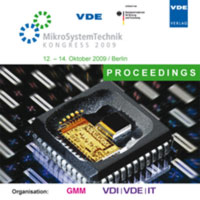Fabrication of mono-crystalline Silicon Micro-mirror Arrays using adhesive Wafer Transfer Bonding
Conference: MikroSystemTechnik - KONGRESS 2009
10/12/2009 - 10/14/2009 at Berlin, Germany
Proceedings: MikroSystemTechnik
Pages: 4Language: englishTyp: PDF
Personal VDE Members are entitled to a 10% discount on this title
Authors:
Zimmer, Fabian; Bring, Martin; List, Matthias (Fraunhofer IPMS, 01109 Dresden, Germany)
Lapisa, Martin; Niklaus, Frank (KTH (Royal Institute of Technology), Stockholm, Sweden)
Abstract:
Spatial light modulators (SLMs) based on individually addressable micro-mirrors do show an increased use in projection displays, DUV lithography and adaptive optics. Mirror planarity and deflection characteristics are important issues for these applications. Mono-crystalline silicon as mirror material offers a great possibility to combine the perfect surface with the good mechanical properties of the crystalline material. Nevertheless, the challenge is the integration of mono-crystalline silicon in a CMOS process with low temperature budget (below 450deg C) and restricted material options. Thus, standard processes like epitaxial growth or re-crystallization of poly-silicon cannot be used. We will present a CMOS-compatible approach, using adhesive wafer transfer bonding with Benzocyclobutene (BCB) of a 300nm thin silicon membrane, located on a SOI donor wafer. After the bond process, the SOI donor wafer is grinded and spin etched to remove the handle silicon and the buried oxide layer, which results in a transfer of the mono-crystalline silicon membrane to the CMOS wafer. This technology is fully compatible for integration in a CMOS process, in order to fabricate SLMs, consisting of one million individually addressable mono-crystalline silicon micro-mirrors. In this paper, we present fabrication process as well as first results of SLM devices with a pixel pitch of 16micrometer.


